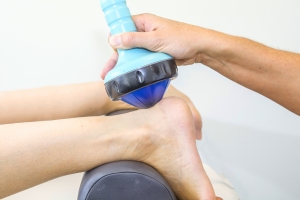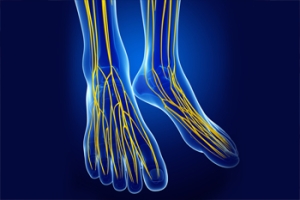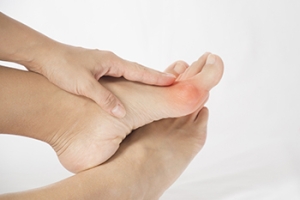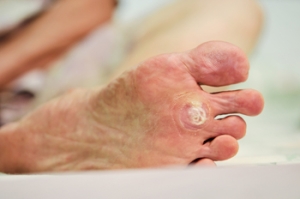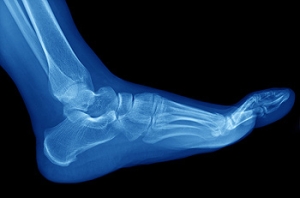
What Can a Doppler Ultrasound Detect?
 If your podiatrist suspects that you have poor circulation in your lower limbs they may suggest having a Doppler ultrasound exam performed. A Doppler ultrasound is an imaging study that uses sound waves to measure the amount of blood flow through your arteries and veins. This test can be used to detect conditions such as deep vein thrombosis, superficial thrombophlebitis, arteriosclerosis, thromboangiitis obliterans, and vascular tumors. A podiatrist may also use the Doppler ultrasound to check for blood vessel damage or narrowing or hardening of blood vessels, which can interrupt blood flow to the feet and legs. Once the cause of your poor circulation has been found, your doctor will be able to determine the next steps in treating and managing your condition. If you suffer from poor circulation in your feet or ankles, please seek the care of a podiatrist.
If your podiatrist suspects that you have poor circulation in your lower limbs they may suggest having a Doppler ultrasound exam performed. A Doppler ultrasound is an imaging study that uses sound waves to measure the amount of blood flow through your arteries and veins. This test can be used to detect conditions such as deep vein thrombosis, superficial thrombophlebitis, arteriosclerosis, thromboangiitis obliterans, and vascular tumors. A podiatrist may also use the Doppler ultrasound to check for blood vessel damage or narrowing or hardening of blood vessels, which can interrupt blood flow to the feet and legs. Once the cause of your poor circulation has been found, your doctor will be able to determine the next steps in treating and managing your condition. If you suffer from poor circulation in your feet or ankles, please seek the care of a podiatrist.
Vascular testing plays an important part in diagnosing disease like peripheral artery disease. If you have symptoms of peripheral artery disease, or diabetes, consult with Joe Mathew George DPM, FACFAS from Illinois. Our doctor will assess your condition and provide you with quality foot and ankle treatment.
What Is Vascular Testing?
Vascular testing checks for how well blood circulation is in the veins and arteries. This is most often done to determine and treat a patient for peripheral artery disease (PAD), stroke, and aneurysms. Podiatrists utilize vascular testing when a patient has symptoms of PAD or if they believe they might. If a patient has diabetes, a podiatrist may determine a vascular test to be prudent to check for poor blood circulation.
How Is it Conducted?
Most forms of vascular testing are non-invasive. Podiatrists will first conduct a visual inspection for any wounds, discoloration, and any abnormal signs prior to a vascular test.
The most common tests include:
- Ankle-Brachial Index (ABI) examination
- Doppler examination
- Pedal pulses
These tests are safe, painless, and easy to do. Once finished, the podiatrist can then provide a diagnosis and the best course for treatment.
If you have any questions, please feel free to contact our offices located in Joliet, Bolingbrook, and Channahon, IL . We offer the newest diagnostic and treatment technologies for all your foot care needs.
Vascular Testing in Podiatry
In foot care, vascular testing may be required in the diagnosing and treatment of certain podiatric conditions. Vascular testing is particularly relevant for patients with high-risk diabetes, poor circulation, peripheral artery disease (PAD), and chronic venous insufficiency (CVI). Procedures typically involve the examination of blood vessels throughout the body for blockages or buildup.
Vascular testing is very important for the diagnosis of various conditions, including peripheral artery disease and chronic venous insufficiency, as these conditions can greatly affect one’s quality of life and cause pain in the lower limbs. Circulatory problems in the feet and ankles can reflect issues throughout the body, making testing of the blood vessels pertinent.
Testing methods vary between practitioners and can be specific to certain foot and ankle problems. Modern technology has brought about the ability to perform vascular testing using non-invasive methods, such as the cuff-based PADnet testing device. This device records the Ankle-Brachial Index (ABI)/Toe-Brachial Index (TBI) values and Pulse Volume Recording (PVR) waveforms. Contact your podiatrist to determine what vascular testing is available for your needs.
What Does the Acronym PAD Stand For?
Peripheral Artery Disease (PAD) is a restriction of blood flow to the muscles and organs due to the build-up of plaque on artery walls. PAD starves muscles and organs of the oxygen and nutrients they need to function properly—especially during physical activities. This lack of oxygen-rich blood to the extremities can make it difficult to walk and can also cause pain in the feet and legs. This pain from PAD can go undetected in people who also suffer from diabetes and neuropathy, possibly leading to foot sores which—when caused by severe blood flow reduction—can increase the risk of amputation. Individuals who are afflicted with PAD and/or diabetes should be under the care of a podiatrist who can help to manage these conditions and improve overall health.
Peripheral artery disease can pose a serious risk to your health. It can increase the risk of stroke and heart attack. If you have symptoms of peripheral artery disease, consult with Joe Mathew George DPM, FACFAS from Illinois. Our doctor will assess your condition and provide you with quality foot and ankle treatment.
Peripheral artery disease (PAD) is when arteries are constricted due to plaque (fatty deposits) build-up. This results in less blood flow to the legs and other extremities. The main cause of PAD is atherosclerosis, in which plaque builds up in the arteries.
Symptoms
Symptoms of PAD include:
- Claudication (leg pain from walking)
- Numbness in legs
- Decrease in growth of leg hair and toenails
- Paleness of the skin
- Erectile dysfunction
- Sores and wounds on legs and feet that won’t heal
- Coldness in one leg
It is important to note that a majority of individuals never show any symptoms of PAD.
Diagnosis
While PAD occurs in the legs and arteries, Podiatrists can diagnose PAD. Podiatrists utilize a test called an ankle-brachial index (ABI). An ABI test compares blood pressure in your arm to you ankle to see if any abnormality occurs. Ultrasound and imaging devices may also be used.
Treatment
Fortunately, lifestyle changes such as maintaining a healthy diet, exercising, managing cholesterol and blood sugar levels, and quitting smoking, can all treat PAD. Medications that prevent clots from occurring can be prescribed. Finally, in some cases, surgery may be recommended.
If you have any questions, please feel free to contact our offices located in Joliet, Bolingbrook, and Channahon, IL . We offer the newest diagnostic and treatment technologies for all your foot care needs.
Peripheral Artery Disease
Peripheral artery disease (PAD), or peripheral arterial disease, is a circulatory problem in which there is a reduction of blood flow to the limbs due to narrowed arteries. When peripheral artery disease develops, the extremities do not receive enough blood flow; this may cause symptoms to develop such as claudication, or leg pain when walking. The legs are the most common site of peripheral artery disease.
Claudication, or leg pain when walking, is one of several symptoms that can develop due to peripheral artery disease. Other symptoms caused by the disease include painful cramping in the hips, thighs, or calves after certain activities; leg numbness or weakness; coldness in the lower leg or foot; sores on the lower extremities that do not heal; hair loss on the lower extremities; and a missing or weak pulse in the lower extremities. In more severe cases, pain may even occur when the body is at rest or when lying down.
Peripheral artery disease is typically caused by atherosclerosis, a condition in which fatty deposits build up in the arterial walls and reduce blood flow. Smoking, diabetes, obesity, high blood pressure, and high cholesterol are some of the risk factors for peripheral artery disease.
If you are experiencing pain, numbness, or other symptoms in the lower extremities, see your healthcare professional immediately. Diagnosed peripheral artery disease can be treated with various medications, angioplasty and surgery, exercise programs, or alternative medicine. It is important to consult a healthcare professional to determine the best treatment for you.
Is Bunion Surgery an Option?
 Patients who are afflicted with a bunion may choose to have surgery that can permanently repair this foot condition. A bunion is defined as a large, bony protrusion that develops on the bottom of the big toe. Common causes for a bunion to form can include genetic factors, or from wearing shoes that do not fit correctly. For severe bunions, many patients consider having surgery repair the affected joint. Additionally, bunion surgery may be successful in correcting the ligaments and tendons that may have shifted from the growing bunion. If you have a bunion, and are considering having surgery performed, it is strongly suggested that a podiatrist be consulted for an in depth discussion about the risks and rewards of bunion surgery.
Patients who are afflicted with a bunion may choose to have surgery that can permanently repair this foot condition. A bunion is defined as a large, bony protrusion that develops on the bottom of the big toe. Common causes for a bunion to form can include genetic factors, or from wearing shoes that do not fit correctly. For severe bunions, many patients consider having surgery repair the affected joint. Additionally, bunion surgery may be successful in correcting the ligaments and tendons that may have shifted from the growing bunion. If you have a bunion, and are considering having surgery performed, it is strongly suggested that a podiatrist be consulted for an in depth discussion about the risks and rewards of bunion surgery.
If you are suffering from bunion pain, contact Joe Mathew George DPM, FACFAS of Illinois. Our doctor can provide the care you need to keep you pain-free and on your feet.
What Is a Bunion?
Bunions are painful bony bumps that usually develop on the inside of the foot at the joint of the big toe. As the deformity increases over time, it may become painful to walk and wear shoes. Women are more likely to exacerbate existing bunions since they often wear tight, narrow shoes that shift their toes together. Bunion pain can be relieved by wearing wider shoes with enough room for the toes.
Causes
- Genetics – some people inherit feet that are more prone to bunion development
- Inflammatory Conditions - rheumatoid arthritis and polio may cause bunion development
Symptoms
- Redness and inflammation
- Pain and tenderness
- Callus or corns on the bump
- Restricted motion in the big toe
In order to diagnose your bunion, your podiatrist may ask about your medical history, symptoms, and general health. Your doctor might also order an x-ray to take a closer look at your feet. Nonsurgical treatment options include orthotics, padding, icing, changes in footwear, and medication. If nonsurgical treatments don’t alleviate your bunion pain, surgery may be necessary.
If you have any questions, please feel free to contact our offices located in Joliet, Bolingbrook, and Channahon, IL . We offer the newest diagnostic and treatment technologies for all your foot care needs.
Bunions
A bunion is an enlargement of the base joint of the toe that connects to the foot, often formed from a bony growth or a patch of swollen tissues. It is caused by the inward shifting of the bones in the big toe, toward the other toes of the foot. This shift can cause a serious amount of pain and discomfort. The area around the big toe can become inflamed, red, and painful.
Bunions are most commonly formed in people who are already genetically predisposed to them or other kinds of bone displacements. Existing bunions can be worsened by wearing improperly fitting shoes. Trying to cram your feet into high heels or running or walking in a way that causes too much stress on the feet can exacerbate bunion development. High heels not only push the big toe inward, but shift one's body weight and center of gravity towards the edge of the feet and toes, expediting bone displacement.
A podiatrist knowledgeable in foot structure and biomechanics will be able to quickly diagnose bunions. Bunions must be distinguished from gout or arthritic conditions, so blood tests may be necessary. The podiatrist may order a radiological exam to provide an image of the bone structure. If the x-ray demonstrates an enlargement of the joint near the base of the toe and a shifting toward the smaller toes, this is indicative of a bunion.
Wearing wider shoes can reduce pressure on the bunion and minimize pain, and high heeled shoes should be eliminated for a period of time. This may be enough to eliminate the pain associated with bunions; however, if pain persists, anti-inflammatory drugs may be prescribed. Severe pain may require an injection of steroids near the bunion. Orthotics for shoes may be prescribed which, by altering the pressure on the foot, can be helpful in reducing pain. These do not correct the problem; but by eliminating the pain, they can provide relief.
For cases that do not respond to these methods of treatment, surgery can be done to reposition the toe. A surgeon may do this by taking out a section of bone or by rearranging the ligaments and tendons in the toe to help keep it properly aligned. It may be necessary even after surgery to wear more comfortable shoes that avoid placing pressure on the toe, as the big toe may move back to its former orientation toward the smaller toes.
Can Children Get Plantar Warts?
 The papillomavirus is responsible for warts in both adults and children. Although pediatric warts are said to be more common, anyone can become affected. Warts are usually not painful unless they occur on the soles of the feet, as is the case with plantar warts. These flat, thick, callus-like warts can grow singularly or even in a cluster, causing a “mosaic” on the bottom of the feet. Sometimes small black dots, which are clotted blood vessels, may be visible within the wart. While warts usually go away after some time, they can be quite tender and stubborn. If your child has developed plantar warts that are painful or persistent, it is suggested that you make an appointment with a podiatrist. A podiatrist can use a variety of medicines and treatments depending on the severity of the warts, your child’s age, medical history, and tolerance for medical procedures.
The papillomavirus is responsible for warts in both adults and children. Although pediatric warts are said to be more common, anyone can become affected. Warts are usually not painful unless they occur on the soles of the feet, as is the case with plantar warts. These flat, thick, callus-like warts can grow singularly or even in a cluster, causing a “mosaic” on the bottom of the feet. Sometimes small black dots, which are clotted blood vessels, may be visible within the wart. While warts usually go away after some time, they can be quite tender and stubborn. If your child has developed plantar warts that are painful or persistent, it is suggested that you make an appointment with a podiatrist. A podiatrist can use a variety of medicines and treatments depending on the severity of the warts, your child’s age, medical history, and tolerance for medical procedures.
Plantar warts can be very uncomfortable. If you need your feet checked, contact Joe Mathew George DPM, FACFAS from Illinois. Our doctor will assist you with all of your foot and ankle needs.
About Plantar Warts
Plantar warts are the result of HPV, or human papillomavirus, getting into open wounds on the feet. They are mostly found on the heels or balls of the feet.
While plantar warts are generally harmless, those experiencing excessive pain or those suffering from diabetes or a compromised immune system require immediate medical care. Plantar warts are easily diagnosed, usually through scraping off a bit of rough skin or by getting a biopsy.
Symptoms
- Lesions on the bottom of your feet, usually rough and grainy
- Hard or thick callused spots
- Wart seeds, which are small clotted blood vessels that look like little black spots
- Pain, discomfort, or tenderness of your feet when walking or standing
Treatment
- Freezing
- Electric tool removal
- Laser Treatment
- Topical Creams (prescription only)
- Over-the-counter medications
To help prevent developing plantar warts, avoid walking barefoot over abrasive surfaces that can cause cuts or wounds for HPV to get into. Avoiding direct contact with other warts, as well as not picking or rubbing existing warts, can help prevent the further spread of plantar warts. However, if you think you have developed plantar warts, speak to your podiatrist. He or she can diagnose the warts on your feet and recommend the appropriate treatment options.
If you have any questions please feel free to contact our offices located in Joliet, Bolingbrook, and Channahon, IL . We offer the newest diagnostic and treatment technologies for all your foot and ankle needs.
What Are Plantar Warts?
Plantar warts are described as small growths that appear on the heels or other areas of the feet that bear a large amount of weight. The pressure in these areas causes plantar warts to hide behind thick layers of skin called calluses. In most cases, plantar warts are not a serious health issue, and they usually go away without treatment. However, it is still important be mindful of them.
Plantar warts are caused by infections with human papillomavirus (HPV) in the outer layer of skin on the soles of the feet. The plantar warts then develop when the virus enters the body through weak spots at the bottom of the feet, such as tiny cuts and breaks. Plantar warts are not guaranteed for all who encounter the virus. Everyone responds differently to the affects of HPV.
Plantar warts are most common in the following groups: children and teenagers, people with weakened immune systems, people with history of plantar warts, and people who walk barefoot. Exposure to HPV is common in environments such as locker rooms or pool areas.
One of early signs to look out for is a callus, since many plantar warts hide behind them. You can also locate these warts by looking for small, fleshy, rough, grainy growths near the base of the toes and the heel. Early signs of plantar warts are shown by black pinpoints, which are small, clotted blood vessels. Lesions that interrupt normal lines and ridges in the skin of your foot may also be a sign of plantar warts. Any feeling of pain while walking or standing can also be a symptom of plantar warts.
Although most cases are not serious, some conditions may require a visit to your podiatrist. If you are uncertain that your lesion is a wart, if you have diabetes, or if you are experiencing bleeding, you may need to see a seek professional treatment. Your doctor may offer treatments such as prescribing stronger peeling medicine or using cryotherapy by applying liquid nitrogen to the wart. More serious cases may require minor surgery or laser treatment.
There are simple solutions available to help prevent plantar warts. One common task is to avoid walking barefoot in swimming pool areas and locker rooms, as this is where HPV is commonly present. Keeping your feet clean and dry, while changing shoes and socks daily can also help prevent future plantar warts. If you know someone who has plantar warts, it is important to avoid direct contact with their warts. You should also refrain from picking or scratching your wart if you happen to develop one.
Elevation May Bring Relief to Stress Fractures in the Feet
 The bones that are located in the feet can be affected by stress fractures. Stress fractures are hairline fractures that can gradually develop from overuse. They can form as a result of a sudden change in footwear, running on uneven surfaces, or suddenly increasing the intensity in running and jumping activities. Common symptoms that many patients experience can include tenderness surrounding the injured area, in addition to severe pain when the activity is completed. Mild relief can be found when the affected foot is elevated, and this may help to increase circulation to the heart. If you feel you have endured a stress fracture in your foot, it is advised that you seek the counsel of a podiatrist who can properly diagnose and treat stress fractures.
The bones that are located in the feet can be affected by stress fractures. Stress fractures are hairline fractures that can gradually develop from overuse. They can form as a result of a sudden change in footwear, running on uneven surfaces, or suddenly increasing the intensity in running and jumping activities. Common symptoms that many patients experience can include tenderness surrounding the injured area, in addition to severe pain when the activity is completed. Mild relief can be found when the affected foot is elevated, and this may help to increase circulation to the heart. If you feel you have endured a stress fracture in your foot, it is advised that you seek the counsel of a podiatrist who can properly diagnose and treat stress fractures.
Activities where too much pressure is put on the feet can cause stress fractures. To learn more, contact Joe Mathew George DPM, FACFAS from Illinois. Our doctor can provide the care you need to keep your pain free and on your feet.
Dealing with Stress Fractures of the Foot and Ankle
Stress fractures occur in the foot and ankle when muscles in these areas weaken from too much or too little use. The feet and ankles then lose support when walking or running from the impact of the ground. Since there is no protection, the bones receive the full impact of each step. Stress on the feet can cause cracks to form in the bones, thus creating stress fractures.
What Are Stress Fractures?
Stress fractures occur frequently in individuals whose daily activities cause great impact on the feet and ankles. Stress factors are most common among:
- Runners
- People affected with Osteoporosis
- Tennis or basketball players
- Gymnasts
- High impact workouts
Symptoms
Pain from the fractures occur in the area of the fractures and can be constant or intermittent. It will often cause sharp or dull pain with swelling and tenderness. Engaging in any kind of activity which involves high impact will aggravate pain.
If you have any questions please feel free to contact our offices located in Joliet, Bolingbrook, and Channahon, IL . We offer the newest diagnostic and treatment technologies for all your foot and ankle needs.
